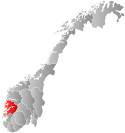Sveio: Difference between revisions
No edit summary |
m fix infobox image |
||
| Line 6: | Line 6: | ||
| other_name = |
| other_name = |
||
| official_name = |
| official_name = |
||
| image_skyline = |
| image_skyline = Bømlafjordtunnelen.jpg |
||
| idnumber = 1216 |
| idnumber = 1216 |
||
| county = Hordaland |
| county = Hordaland |
||
Revision as of 15:32, 19 June 2010
Sveio Municipality
Sveio kommune | |
|---|---|
 | |
|
| |
 Hordaland within Norway | |
 Sveio within Hordaland | |
| Country | Norway |
| County | Hordaland |
| District | Haugaland |
| Administrative centre | Sveio |
| Government | |
| • Mayor (2003) | Jorunn Skåden (Ap) |
| Area | |
| • Total | 246 km2 (95 sq mi) |
| • Land | 224 km2 (86 sq mi) |
| • Rank | #306 in Norway |
| Population (2004) | |
| • Total | 4,687 |
| • Rank | #203 in Norway |
| • Density | 21/km2 (50/sq mi) |
| • Change (10 years) | |
| Demonym | Sveibu[1] |
| Official language | |
| • Norwegian form | Nynorsk |
| Time zone | UTC+01:00 (CET) |
| • Summer (DST) | UTC+02:00 (CEST) |
| ISO 3166 code | NO-1216[3] |
| Website | Official website |
| Year | Pop. | ±% |
|---|---|---|
| 1951 | 1,954 | — |
| 1960 | 1,782 | −8.8% |
| 1970 | 3,477 | +95.1% |
| 1980 | 4,216 | +21.3% |
| 1990 | 4,582 | +8.7% |
| 2000 | 4,623 | +0.9% |
| 2007 | 4,764 | +3.0% |
| 2008 | 4,825 | +1.3% |
| 2009 | 4,906 | +1.7% |
| Source: Statistics Norway. | ||
Sveio is a municipality in the county of Hordaland, Norway. It is located in the traditional district of Haugaland. The administrative centre is the village of Sveio.
Sveio was separated from Finnås in 1861. Vikebygd was separated from Sveio on January 1, 1902. Valestrand (and the western part of Vikebygd) was merged back into Sveio on January 1, 1964.
General information
Name
The municipality (originally the parish) is named after the Sveio farm (Old Norse Sviða), since the first church was built there. The name is identical with the word sviða which means a "clearing made by burning". Before 1912, the name was written Sveen.[4]
Coat-of-arms
The coat-of-arms is from modern times. They were granted on 19 February 1982. The arms show a cut fleur-de-lis, an unusual symbol, derived from the arms of Jon Gauteson from Sveio, who lived around 1500. He was the first of his family, who were incorporated in the Norwegian nobility in 1591, to use this symbol.[5]
References
- ^ "Navn på steder og personer: Innbyggjarnamn" (in Norwegian). Språkrådet.
- ^ "Forskrift om målvedtak i kommunar og fylkeskommunar" (in Norwegian). Lovdata.no.
- ^ Bolstad, Erik; Thorsnæs, Geir, eds. (2023-01-26). "Kommunenummer". Store norske leksikon (in Norwegian). Kunnskapsforlaget.
- ^ Jukvam, Dag (1999). "Historisk oversikt over endringer i kommune- og fylkesinndelingen" (PDF). Statistisk sentralbyrå. Template:No icon
- ^ Norske Kommunevåpen (1990). "Nye kommunevåbener i Norden". Retrieved 27 September 2008.



